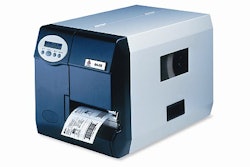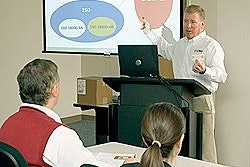PW: What would you say are the major trends for the packaging industry in 2006, and how does Pack Expo fit in?
Yuska:Multiple market forces are playing strong roles in the packaging forecasting that all consumer and industrial goods companies are doing right now. Rising energy costs, sustainable packaging, and anticipated “crises” such as natural disasters and potential health emergencies such as Avian Flu, SARS, etc., are just a few of the issues that are facing the packaged goods industry. The result is that all packaging managers will need to reevaluate their current packaging operations and supply chains.
Part of this strategic evaluation will be considering “What if” scenarios and alternative packaging/business models in which “supplier” and “customer” identities are blurred. The trend we’re seeing is that the packaging service sector is expanding into a collaborative network of contributors that spans the market from raw materials through production, distribution, marketing, consumption and disposal/processing/harvesting of “post-consumption” materials.
Another significant market force is Wal-Mart. We’re watching its recently announced sustainable packaging initiative closely. Only a few years ago it was RFID that Wal-Mart wanted to use to monitor their supply chain. All of us saw the tremendous amount of innovation and review of operations resulting from that decision.
It’s too early to tell what implications this will have in the marketplace, but PMMI, through its Pack Expo tradeshow, will play a strong role in the developing solutions. Next year’s show will be the single, most comprehensive supply chain event in the world, and we’ll be celebrating our 50th anniversary.
PW: As you look ahead to 2006, what are some of the challenges facing the packaging industry?
Yuska:The ongoing globalization of the packaging market is certainly one key challenge. Customers have become increasingly global, causing packaging suppliers to also go global to service the needs of multinational companies.
Adapting to emerging technology is another challenge. Topics like anti-counterfeiting and brand protection, commercializing innovative designs made of new compounds and thinner gauge specifications, and RFID systems are key issues in today’s packaging marketplace. Suppliers across the board are making concerted efforts to ensure their brands keep up and master these technologies as well as keeping an eye on emerging technologies.
PW: What would you say is the biggest opportunity for the packaging industry in 2006?
Yuska:Innovation itself is the opportunity—both in terms of package design and technology. In terms of design, it’s no secret that packaging appearance, convenience, and product freshness are critical for brand success.
However, making certain that package designs can be produced efficiently in the volumes required is another key component. That is why it’s critical that consumer goods companies bring their machinery suppliers into the packaging innovation process much earlier. Having a great design idea and securing a solid materials partner are two elements of success. Being sure to incorporate the right machinery supplier who can actually bring the idea to market is the true opportunity.
When added together, innovation in design and technology result in a powerful formula for building successful brands by meeting customer business goals and consumer needs.
Packagers can realize this formula by participating in Pack Expo International, which covers the spectrum of global packaging innovations. The show brings together an international exhibitor and attendee base, offering many opportunities to discuss common issues and problem-solving strategies. Also, examining how advanced materials and machinery can work in concert together will have a strong impact on the bottom line and enable brands to stay competitive in today’s—and tomorrow’s—marketplace.
PW: 2006 is the 50th anniversary of Pack Expo. Can you give us some statistics from the very first show?
Yuska:The inaugural Pack Expo was held in October 1956 in Cleveland, Ohio. There were 136 exhibitors occupying 43걔 net square feet of floor space. Approximately 5ꯠ packaging professionals were in attendance. After moving around to several different venues, including Atlantic City, New York, and Detroit, the show finally settled in Chicago in 1965, with one other show held in New York in the 80’s.
By this time, the show had grown to 207 exhibitors and 120꾝 net square feet. Attendance had also increased to 14꾠.
But the most important piece of data Packaging World readers should know is that Pack Expo has evolved into a comprehensive, multi-layered event that has it all: machinery, materials, containers and components. The show is the forum for serious packaging dialogue and collaboration.
PW: How does the modern Pack Expo stack up compared to shows from year’s past?
Yuska:It’s more comprehensive and focused across the entire supply chain. From the beginning, Pack Expo has been an innovations-driven show that highlights packaging as a powerful means to build stronger brands. The interdependence of materials and containers and machinery cannot be overemphasized. Advanced materials and containers add differentiation to increase turnover at the retail shelf and bring greater convenience to build stronger brand equity. Machinery innovations help speed new product commercialization, another critical factor in brand success.
By showcasing all of these solutions under one roof, Pack Expo makes it easy for marketers, designers, R&D specialists, packaging engineers, plant managers and purchasing professionals from all over the world to find solutions that increase retail sales, grow brand loyalty, and build greater market share. No other show offers this powerful combination.
When you add the co-locations of the Food Processing Machinery Expo (FPM Expo) and Converting & Package Printing (CPP) Expo, there’s even more reasons to attend.
We’re expecting 76ꯠ attendees at Pack Expo International 2006 from every conceivable market sector. That’s another differentiator. The show truly reflects every market sector: from food and beverage to toys and automotive.
PW: How does consolidation in the end-user community impact your members, many of whom are small businesses and often second and third generation family-owned companies?
Yuska:Consolidation presents members with fresh opportunities to work with reconstituted packaging departments and address issues presented by multiple pieces of legacy equipment.
It’s a challenge to meld operational approaches that were not originally designed to work together. Maximizing the performance of operations that may have been physically moved and cobbled together is a unique challenge that can only be addressed by close cooperation between the consumer goods company and their supply chain partner.
I think the end user community is concerned about one thing: getting a package to market. PMMI members are 100% committed to this business objective, no matter how their companies are set up.
PW: Do you foresee the supplier base consolidating in the near future?
Yuska: From a long-term marketplace perspective, there really hasn’t been a large scale consolidation of the industry, though the “experts” have been calling for this for years now.
There clearly have been a few companies who have significantly grown their businesses through mergers and acquisitions. But we have yet to see the “rule of 3” effect that other industries have experienced where the supplier base is rolled up into three companies that dominate the industry.
This has happened in other parts of the packaging business such as the glass industry, but not in machinery. In fact, 10 years ago we had 352 members. Today we have 514. So the industry has seen a 31% growth of suppliers in the last 10 years, not a net consolidation.
PW: The fact that many of these second and third generation family-owned companies are growing and thriving seems to buck the trend of consolidation we just discussed. How do they continue to stay successful?
Yuska:No matter how a company is operated, a good product is the primary driver of success. Successful PMMI members all follow the same basic model—anticipating and offering customers what they want and servicing what they sell—at a fair price. By actively marketing their abilities and differentiators, companies are bound to thrive—period.
PMMI members are responding to market needs with a “total solutions” perspective. They are working closely with other OEMs to bring a complete system to customers. Providing a “total systems” product offering doesn’t necessarily mean suppliers have to merge or consolidate.
However, it does mean that they have to develop alliances and collaborations that have some synergy.
PMMI’s defining tagline—“Leading companies. Leading solutions”—reflects our members’ commitment to their customers. When you realize that in the last 10 years, one out of every three packaging machines installed anywhere in the world was designed and built by a PMMI member, you can appreciate that the tagline is both a reflection of our members’ past as well as a forecast of things to come. —Pat Reynolds



























